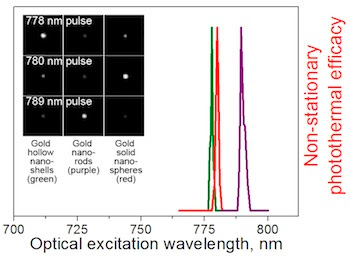

| Visitors Now: | |
| Total Visits: | |
| Total Stories: |

| Story Views | |
| Now: | |
| Last Hour: | |
| Last 24 Hours: | |
| Total: | |
Rice University researchers show short laser pulses selectively heat gold nanoparticles
From
Plasmonic gold nanoparticles make pinpoint heating on demand possible. Now Rice University researchers have found a way to selectively heat diverse nanoparticles that could advance their use in medicine and industry.
“The key idea with gold nanoparticles and plasmonics in general is to convert energy,” Lapotko said. “There are two aspects to this: One is how efficiently you can convert energy, and here gold nanoparticles are world champions. Their optical absorbance is about a million times higher than any other molecules in nature.
The second aspect is how precisely one can use laser radiation to make this photothermal conversion happen,” he said. Particles traditionally respond to wide spectra of light, and not much of it is in the valuable near-infrared region. Near-infrared light is invisible to water and, more critically for biological applications, to tissue.
Different types of nanoparticles – in this case, shells, rods and solid spheres – mixed together can be activated individually with pulsed laser light at different wavelengths, according to researchers at Rice University. The tuned particles’ plasmonic response, enhanced by nanobubbles that form at the surface, can be narrowed to a few nanometers under a spectroscope and are easily distinguishable from each other. Lapotko Group/Rice University
See more and subscribe to NextBigFuture at 2013-01-04 06:30:48 Source: http://nextbigfuture.com/2013/01/rice-university-researchers-show-short.html
Source:



